Antibody data
- Antibody Data
- Antigen structure
- References [2]
- Comments [0]
- Validations
- Immunocytochemistry [1]
- Immunohistochemistry [3]
- Other assay [1]
Submit
Validation data
Reference
Comment
Report error
- Product number
- PA5-93329 - Provider product page

- Provider
- Invitrogen Antibodies
- Product name
- SOD3 Polyclonal Antibody
- Antibody type
- Polyclonal
- Antigen
- Synthetic peptide
- Description
- Positive Samples: 22Rv1, HL-60, Mouse kidney, Mouse lung; Cellular Location: extracellular space Immunogen sequence: WTGEDSAEPN SDSAEWIRDM YAKVTEIWQE VMQRRDDDGA LHAACQVQPS ATLDAAQPRV TGVVLFRQLA PRAKLDAFFA LEGFPTEPNS SSRAIHVHQF GDLSQGCEST GPHYNPLAVP HPQHPGDFGN FAVRDGSLWR YR
- Reactivity
- Human, Mouse, Rat
- Host
- Rabbit
- Isotype
- IgG
- Vial size
- 100 μL
- Concentration
- 1.52 mg/mL
- Storage
- -20°C, Avoid Freeze/Thaw Cycles
Submitted references N-Acetylcysteine Enhances the Recovery of Ischemic Limb in Type-2 Diabetic Mice.
Combination of Antioxidant Enzyme Overexpression and N-Acetylcysteine Treatment Enhances the Survival of Bone Marrow Mesenchymal Stromal Cells in Ischemic Limb in Mice With Type 2 Diabetes.
Zhu Q, Liu X, Zhu Q, Liu Z, Yang C, Wu H, Zhang L, Xia X, Wang M, Hao H, Cui Y, Zhang G, Hill MA, Flaker GC, Zhou S, Liu Z
Antioxidants (Basel, Switzerland) 2022 May 31;11(6)
Antioxidants (Basel, Switzerland) 2022 May 31;11(6)
Combination of Antioxidant Enzyme Overexpression and N-Acetylcysteine Treatment Enhances the Survival of Bone Marrow Mesenchymal Stromal Cells in Ischemic Limb in Mice With Type 2 Diabetes.
Zhu Q, Hao H, Xu H, Fichman Y, Cui Y, Yang C, Wang M, Mittler R, Hill MA, Cowan PJ, Zhang G, He X, Zhou S, Liu Z
Journal of the American Heart Association 2021 Oct 5;10(19):e023491
Journal of the American Heart Association 2021 Oct 5;10(19):e023491
No comments: Submit comment
Supportive validation
- Submitted by
- Invitrogen Antibodies (provider)
- Main image
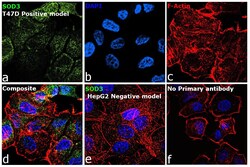
- Experimental details
- Immunofluorescence analysis of Extracellular superoxide dismutase [Cu-Zn] was performed using 70% confluent log phase T-47D and Hep G2 cells. The cells were fixed with 4% paraformaldehyde for 10 minutes, permeabilized with 0.1% Triton™ X-100 for 15 minutes, and blocked with 2% BSA for 45 minutes at room temperature. The cells were labeled with SOD3 Polyclonal Antibody (Product # PA5-93329) at 1:100 in 0.1% BSA, incubated at 4 degree celsius overnight and then labeled with Donkey anti-Rabbit IgG (H+L) Highly Cross-Adsorbed Secondary Antibody, Alexa Fluor Plus 488 (Product # A32790), (1:2000 dilution), for 45 minutes at room temperature (Panel a: Green). Nuclei (Panel b:Blue) were stained with ProLong™ Diamond Antifade Mountant with DAPI (Product # P36962). F-actin (Panel c: Red) was stained with Rhodamine Phalloidin (Product # R415, 1:300). Panel d represents the merged image showing Cytoplasmic localization in T-47D cells but not in HepG2 cells (Panel e) which is reported to be low to negative for SOD3 expression. Panel f represents control cells with no primary antibody to assess background. The images were captured at 60X magnification.
Supportive validation
- Submitted by
- Invitrogen Antibodies (provider)
- Main image
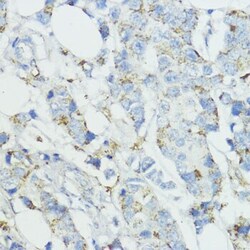
- Experimental details
- Immunohistochemistry analysis of SOD3 in paraffin-embedded human mammary cancer. Samples were incubated with SOD3 Polyclonal antibody (Product # PA5-93329) using a dilution of 1:100 (40x lens). Perform microwave antigen retrieval with 10 mM PBS buffer pH 7.2 before commencing with IHC staining protocol.
- Submitted by
- Invitrogen Antibodies (provider)
- Main image
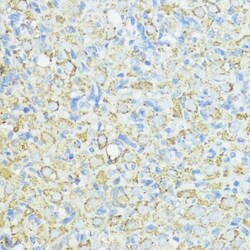
- Experimental details
- Immunohistochemistry analysis of SOD3 in paraffin-embedded rat ovary. Samples were incubated with SOD3 Polyclonal antibody (Product # PA5-93329) using a dilution of 1:100 (40x lens). Perform microwave antigen retrieval with 10 mM PBS buffer pH 7.2 before commencing with IHC staining protocol.
- Submitted by
- Invitrogen Antibodies (provider)
- Main image
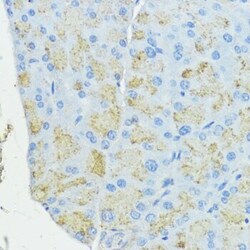
- Experimental details
- Immunohistochemistry analysis of SOD3 in paraffin-embedded mouse pancreas. Samples were incubated with SOD3 Polyclonal antibody (Product # PA5-93329) using a dilution of 1:100 (40x lens). Perform microwave antigen retrieval with 10 mM PBS buffer pH 7.2 before commencing with IHC staining protocol.
Supportive validation
- Submitted by
- Invitrogen Antibodies (provider)
- Main image
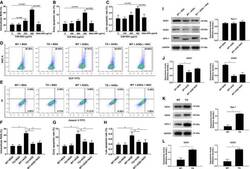
- Experimental details
- Advanced glycation end products (AGEs) impaired the viability of bone marrow mesenchymal stromal cells (bMSCs) through increased reactive oxygen species (ROS) production attributable to selective reduction of superoxide dismutase (SOD)-1 and SOD-3 expression. A through C , Culture of bMSCs with AGE-BSA (with concentration from 100 to 400 mug/mL with BSA as control) significantly increased intracellular ROS ( A ) and early ( B ) and late apoptosis ( C ) in a dose-dependent manner. n=6/group. * P
 Explore
Explore Validate
Validate Learn
Learn Western blot
Western blot ELISA
ELISA Immunocytochemistry
Immunocytochemistry